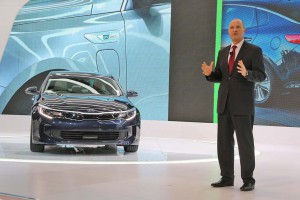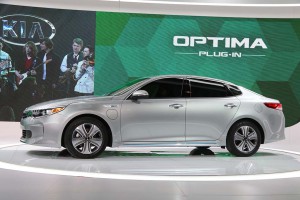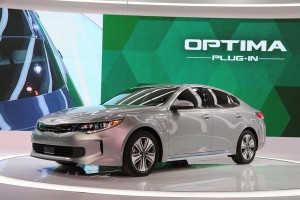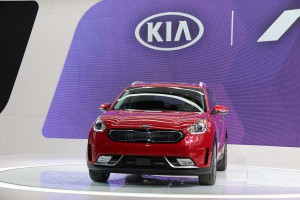Little Korean carmaker Kia has never been shy about bucking trends. And it’s ready to prove that again at the Chicago Auto Show.
Kia is heading into the Windy City with not just one, not just two, but three new battery-based products set to reach U.S. showrooms for the 2017 model-year. That includes both the updated Kia Optima Hybrid, but also the new Kia Optima PHEV, the Korean carmaker’s first plug-in hybrid.
Along with the new Kia Niro, a compact crossover hybrid, the two Optima models are part of the carmaker’s grand plan to triple the number of battery-based models in its fleet by 2020. But whether they’ll gain traction in a market more focused on trucks is far from certain.
“All three of the vehicles being introduced here at the Chicago Auto Show are emblematic of Kia’s commitment to sustainability,” said Orth Hedrick, Kia’s vice president of product planning. To meet a target of increasing the brand’s overall fuel economy by 25% by the end of the decade, he added, “a plug-in hybrid was a critical addition to our offering.”

There's also a redesigned version of the original Kia Optima Hybrid, shown here with product planning chief Orth Hedrick.
Kia used the previous-generation Optima as the base for its first hybrid. And with a new version of the sedan to work from, it’s updating the gas-electric driveline, as well. The goal is to yield a 10% improvement in fuel economy compared to the outgoing model. The 2016 Kia Optima Hybrid gets 36 mpg City, 40 Highway and 38 Combined, according to the EPA.
To get there, Kia has taken a number of steps targeting weight reduction and improving the aerodynamics of the Optima, which now boasts drag coefficient, or Cd, of 0.24, which Kia claims is one of the lowest in the class. To get there, engineers and designers adopted active grille shutters, which close when less cooling air is needed, and air curtains designed to reduce drag around the front wheels.
There’s also a new drivetrain. The old 2.4-liter engine has been replaced with a more compact, 2.0-liter inline-four making 154 horsepower. The hybrid starter generator – which is paired with a six-speed automatic – features a 38 kilowatt electric motor. The overall package turns out 193 horsepower, six less than the old Optima Hybrid.
(Kia to add its first sports sedan next year. For more, Click Here.)
The electric motor is paired with a new lithium-polymer battery pack that, at 1.62 kilowatt-hours, has 13% greater capacity than in the 2016 Optima Hybrid. That allows it to capture and re-use more energy, in turn reducing fuel consumption.
Despite its larger capacity, the new battery is smaller, so it allows for a larger cargo compartment and the use of 60/40 split-folding rear seats.
As for the 2017 Kia Optima PHEV, it starts with the same “Nu” 2.0-liter engine paired with a larger, 50 kilowatt, or 67 horsepower, electric motor. That’s 42% bigger than the motor in the original Kia Optima Hybrid. Power from both sources is routed to the front wheels through a six-speed automatic transmission.
With the PHEV, Kia has turned to a 9.8-kilowatt lithium battery tucked between the back seat and the wheel well – a layout claimed to give the plug-in one of the largest cargo compartments for any model in its class.
In battery mode, the Kia sedan will yield an estimated 27 miles per charge, or roughly half what the second-generation Chevrolet Volt delivers, but twice what the original Toyota Prius plug-in was able to manage.
(Click Here for details about Kia’s Telluride concept shown in Detroit.)
The 2017 Kia Optima PHEV can be switched into one of three modes, including an all-Electric Mode for city driving, a Hybrid Mode for highway driving, and a Charging Mode which actually preserves energy for use later in EV mode.
The Optima plug-in can be fully recharged using a 240-volt Level 2 charger in under three hours, and in less than nine hours on household 120-volt current. There is no high-speed Level 3 charger, however.
Like the more standard Optima Hybrid, a wide range of advanced safety features, including Autonomous Emergency Braking, are available.
The infotainment system includes special EV features, including ones that can help a motorist find a nearby charging station. Kia’s UVO EV Services subscription is offered free for the first three years of ownership.
(To see more about the new 2017 Kia Forte, Click Here.)
Along with the hybrid and plug in hybrid versions of the new Kia Optima, the Korean maker is also debuting its first dedicated hybrid-electric vehicle at this year’s Chicago Auto Show. The new Kia Niro crossover will also reach showrooms later this year.



